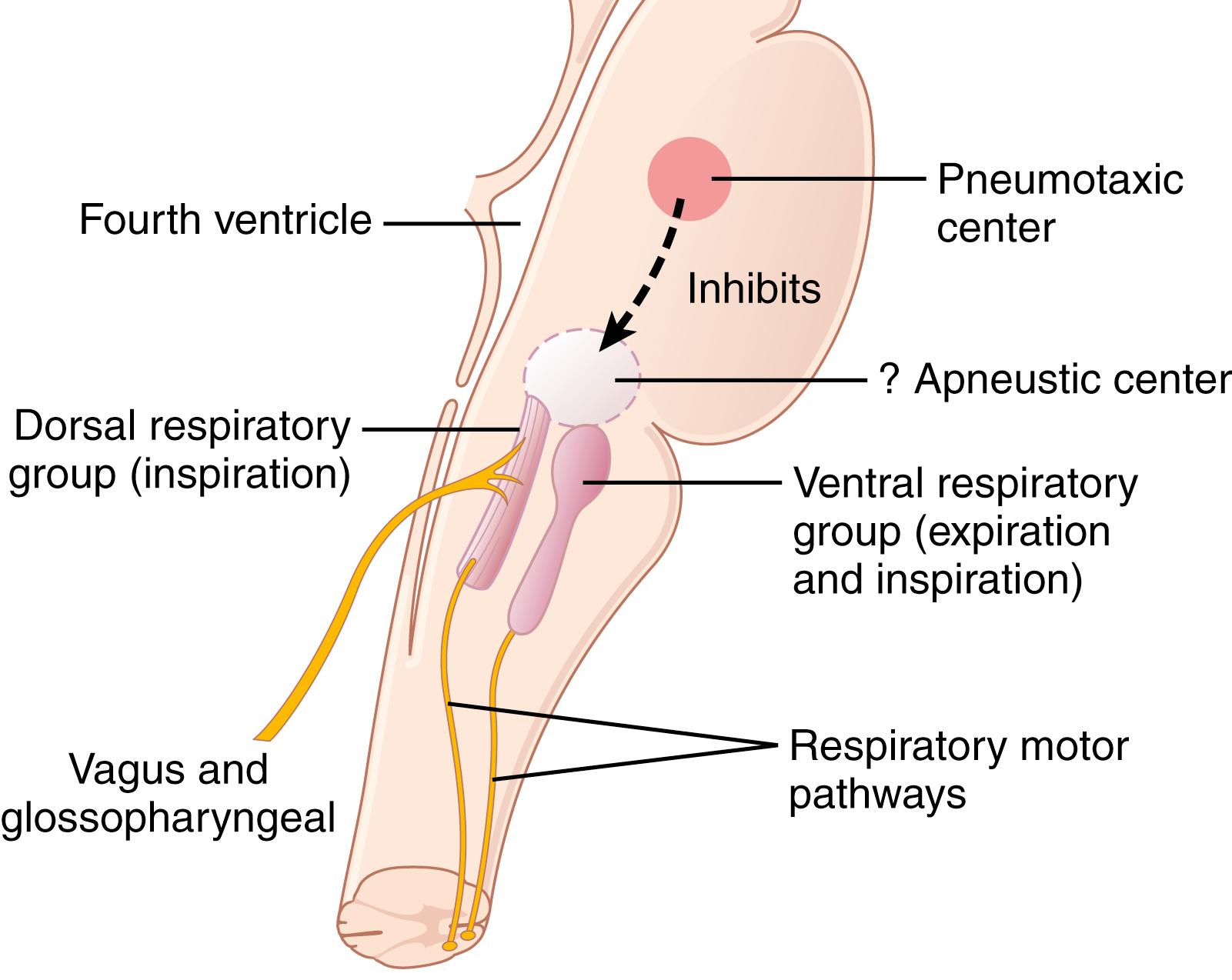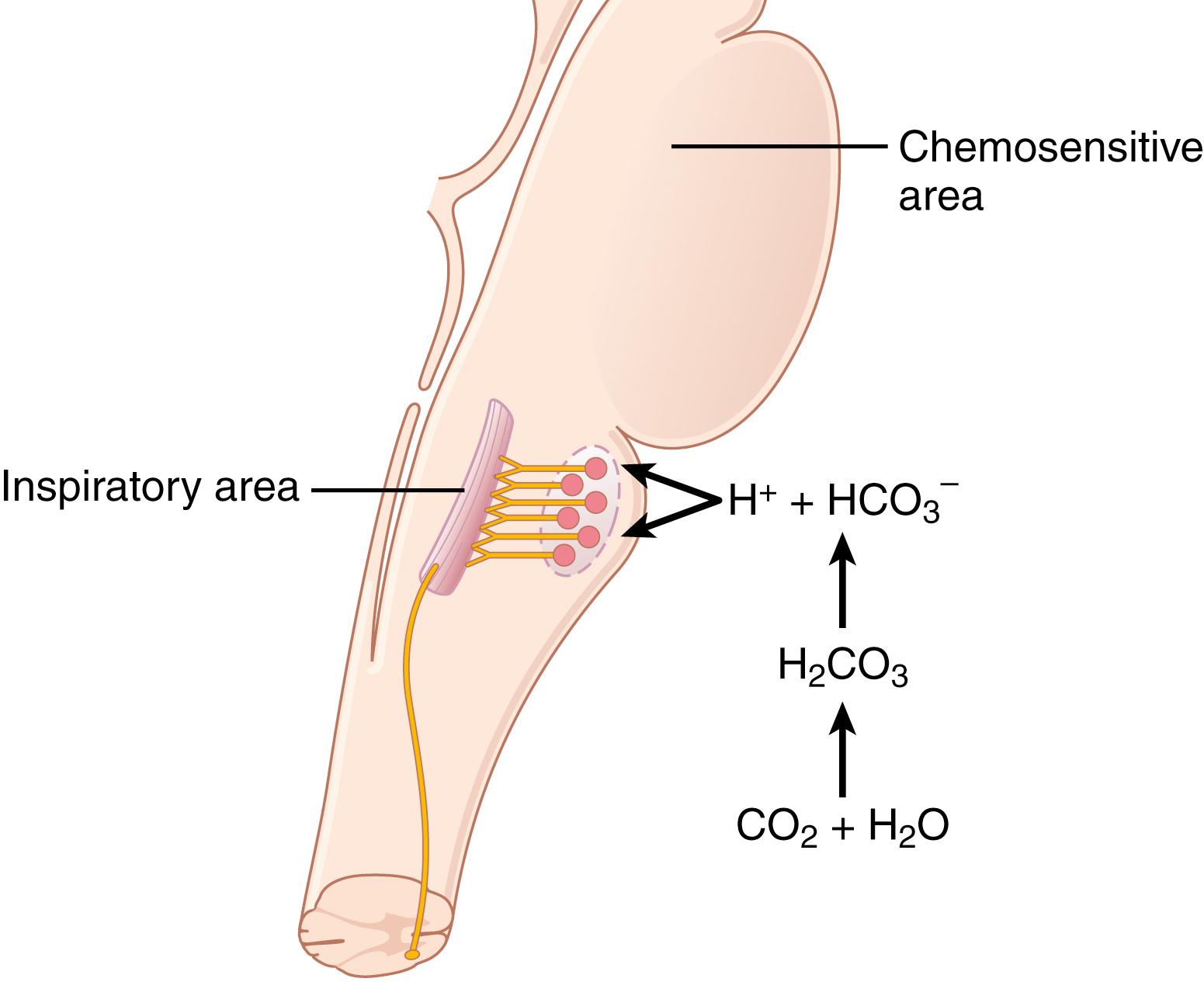Physical Address
304 North Cardinal St.
Dorchester Center, MA 02124
The nervous system normally adjusts the rate of alveolar ventilation to meet the demands of the body almost exactly so that the oxygen partial pressure (P o 2 ) and carbon dioxide partial pressure (P co 2 ) in the arterial blood are hardly altered, even during heavy exercise and most other types of respiratory stress. This chapter describes the function of this neurogenic system for regulation of respiration.
The respiratory center is composed of several groups of neurons located bilaterally in the medulla oblongata and pons of the brain stem, as shown in Figure 42-1 . It is divided into three major collections of neurons: (1) a dorsal respiratory group , located in the dorsal portion of the medulla, which mainly causes inspiration; (2) a ventral respiratory group , located in the ventrolateral part of the medulla, which mainly causes expiration; and (3) the pneumotaxic center , located dorsally in the superior portion of the pons, which mainly controls rate and depth of breathing.

The dorsal respiratory group of neurons plays a fundamental role in the control of respiration and extends most of the length of the medulla. Most of its neurons are located in the nucleus of the tractus solitarius (NTS), although additional neurons in the adjacent reticular substance of the medulla also play important roles in respiratory control. The NTS is the sensory termination of both the vagal and the glossopharyngeal nerves, which transmit sensory signals into the respiratory center from the following: (1) peripheral chemoreceptors; (2) baroreceptors; (3) receptors in the liver, pancreas, and multiple parts of the gastrointestinal tract; and (4) several types of receptors in the lungs.
The basic rhythm of respiration is generated mainly in the dorsal respiratory group of neurons. Even when all the peripheral nerves entering the medulla have been sectioned, and the brain stem has been transected above and below the medulla, this group of neurons still emits repetitive bursts of inspiratory neuronal action potentials . The basic cause of these repetitive discharges is unknown. In primitive animals, neural networks have been found in which activity of one set of neurons excites a second set, which in turn inhibits the first. Then, after a period of time, the mechanism repeats itself, continuing throughout the life of the animal. Similar networks of neurons are present in the human being, located entirely within the medulla; it probably involves not only the dorsal respiratory group but adjacent areas of the medulla as well and is responsible for the basic rhythm of respiration.
The nervous signal that is transmitted to the inspiratory muscles, mainly the diaphragm, is not an instantaneous burst of action potentials. Instead, it begins weakly and increases steadily in a ramp manner for about 2 seconds in normal respiration. It then ceases abruptly for approximately the next 3 seconds, which turns off the excitation of the diaphragm and allows elastic recoil of the lungs and chest wall to cause expiration. Next, the inspiratory signal begins again for another cycle; this cycle repeats again and again, with expiration occurring in between. Thus, the inspiratory signal is a ramp signal . The obvious advantage of the ramp is that it causes a steady increase in the volume of the lungs during inspiration, rather than inspiratory gasps.
Two qualities of the inspiratory ramp are controlled, as follows:
Control of the rate of increase of the ramp signal so that during heavy respiration, the ramp increases rapidly and therefore fills the lungs rapidly.
Control of the limiting point at which the ramp suddenly ceases , which is the usual method for controlling the rate of respiration. That is, the earlier the ramp ceases, the shorter the duration of inspiration. This method also shortens the duration of expiration. Thus, the frequency of respiration is increased.
A pneumotaxic center , located dorsally in the nucleus parabrachialis of the upper pons, transmits signals to the inspiratory area. The primary effect of this center is to control the “switch-off” point of the inspiratory ramp, thereby controlling the duration of the filling phase of the lung cycle. When the pneumotaxic signal is strong, inspiration might last for as little as 0.5 second, thus filling the lungs only slightly; when the pneumotaxic signal is weak, inspiration might continue for 5 or more seconds, thus filling the lungs with much greater amounts of air.
The function of the pneumotaxic center is primarily to limit inspiration, which has a secondary effect of increasing the rate of breathing because limitation of inspiration also shortens expiration and the entire period of each respiration. A strong pneumotaxic signal can increase the rate of breathing to 30 to 40 breaths/min, whereas a weak pneumotaxic signal may reduce the rate to only 3 to 5 breaths/min.
Located in each side of the medulla, about 5 millimeters anterior and lateral to the dorsal respiratory group of neurons, is the ventral respiratory group of neurons , found in the nucleus ambiguus rostrally and the nucleus retroambiguus caudally. The function of this neuronal group differs from that of the dorsal respiratory group in several important ways:
The neurons of the ventral respiratory group remain almost totally inactive during normal quiet respiration. Therefore, normal quiet breathing is caused only by repetitive inspiratory signals from the dorsal respiratory group transmitted mainly to the diaphragm, and expiration results from elastic recoil of the lungs and thoracic cage.
The ventral respiratory neurons do not appear to participate in the basic rhythmical oscillation that controls respiration.
When the respiratory drive for increased pulmonary ventilation becomes greater than normal, respiratory signals spill over into the ventral respiratory neurons from the basic oscillating mechanism of the dorsal respiratory area. As a consequence, the ventral respiratory area also contributes extra respiratory drive.
Electrical stimulation of a few of the neurons in the ventral group causes inspiration, whereas stimulation of others causes expiration. Therefore, these neurons contribute to both inspiration and expiration. They are especially important in providing the powerful expiratory signals to the abdominal muscles during very heavy expiration. Thus, this area operates more or less as an overdrive mechanism when high levels of pulmonary ventilation are required, especially during heavy exercise.
In addition to the central nervous system respiratory control mechanisms operating entirely within the brain stem, sensory nerve signals from the lungs also help control respiration. Most importantly, located in the muscular portions of the walls of the bronchi and bronchioles throughout the lungs are stretch receptors that transmit signals through the vagi into the dorsal respiratory group of neurons when the lungs become overstretched. These signals affect inspiration in much the same way as signals from the pneumotaxic center; that is, when the lungs become overinflated, the stretch receptors activate an appropriate feedback response that “switches off” the inspiratory ramp and thus stops further inspiration. This mechanism is called the Hering-Breuer inflation reflex . This reflex also increases the rate of respiration, as is true for signals from the pneumotaxic center.
In humans, the Hering-Breuer reflex probably is not activated until the tidal volume increases to more than three times normal (>≈1.5 L/breath). Therefore, this reflex appears to be mainly a protective mechanism for preventing excess lung inflation rather than an important factor in normal control of ventilation.
Up to this point, we have discussed the basic mechanisms for causing inspiration and expiration, but it is also important to know how the intensity of the respiratory control signals is increased or decreased to match the ventilatory needs of the body. For example, during heavy exercise, the rates of oxygen (O 2 ) usage and carbon dioxide (CO 2 ) formation are often increased to as much as 20 times normal, requiring commensurate increases in pulmonary ventilation. The major purpose of the rest of this chapter is to discuss this control of ventilation in accord with the respiratory needs of the body.
The ultimate goal of respiration is to maintain proper concentrations of O 2 , CO 2 , and H + in the tissues. It is fortunate, therefore, that respiratory activity is highly responsive to changes in each of these substances.
Excess CO 2 or excess H + in the blood mainly act directly on the respiratory center, causing greatly increased strength of both the inspiratory and the expiratory motor signals to the respiratory muscles. Oxygen, in contrast, does not have a major direct effect on the respiratory center of the brain in controlling respiration. Instead, it acts almost entirely on peripheral chemoreceptors located in the carotid and aortic bodies , and these chemoreceptors in turn transmit appropriate nervous signals to the respiratory center for control of respiration.
We have mainly discussed three areas of the respiratory center—the dorsal respiratory group of neurons, the ventral respiratory group, and the pneumotaxic center. It is believed that none of these is affected directly by changes in blood CO 2 or H + concentration. Instead, an additional neuronal area, a chemosensitive area , shown in Figure 42-2 , is located bilaterally, lying only 0.2 millimeter beneath the ventral surface of the medulla. This area is highly sensitive to changes in either blood P co 2 or H + concentration, and it in turn excites the other portions of the respiratory center.

The sensor neurons in the chemosensitive area are especially excited by H + ; in fact, it is believed that H + may be the only important direct stimulus for these neurons. However, H + ions do not easily cross the blood–brain barrier. For this reason, changes in H + concentration in the blood have considerably less effect in stimulating the chemosensitive neurons than changes in blood CO 2 , even though CO 2 is believed to stimulate these neurons secondarily by changing the H + concentration, as explained in the following section.
Become a Clinical Tree membership for Full access and enjoy Unlimited articles
If you are a member. Log in here